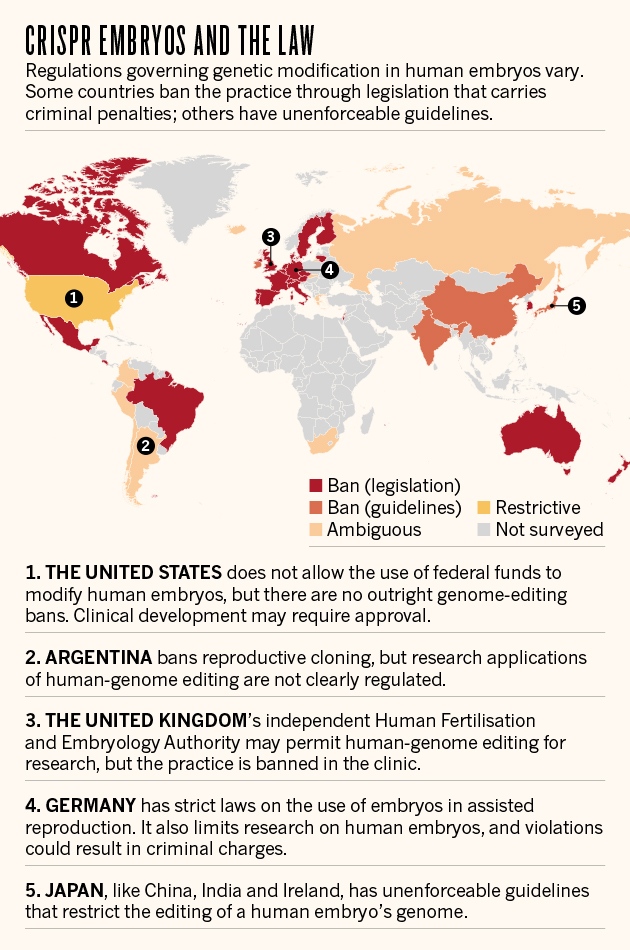This year’s runner up for Time Magazine’s person of the year is not a person, rather a technology known as CRISPR. CRISPR stands for ‘clustered regularly interspaced short palindromic sequences’. Simply put, this is a tool which allows scientists to edit and modify genomes of living beings. This means, that in principle, it is possible for scientists to cure genetic diseases, wipe out entire mosquito species and even produce designer babies. The possibility with this technology is endless and hence needs discussion and discourse outside the domains of the lab.
Within the scope of global politics, while there have been trends of power, there have been trends of technology race too. We see the modern race of technology begin at the cusp of the Industrial Revolution. Nations competed. Then we had the Anthropocene competition and the birth of oil politics. Then the space race and so on. The race of acquisition and in majority cases, weaponization of technology has been a vital theme in politics. The decade of 2000 introduced us to the human genome, and thereafter began the race of the genome and allied areas in genetics. We have had remarkable breakthroughs from potential cure(s) for diseases like cancer to the development of efficient diagnostic tests. Countries like Brazil went so far to use gene editing to wipe out populations of dengue carrying mosquitos. There has been the actual possibility to extinction and de-extinction event, and the field of genetics during the last two decades has flourished as if out of a script of a science fiction novel. The likes of Micheal Crichton would be proud. Within the domain of science, there has been a running debate on the ethics of gene editing, however, little has been done to regulate this at the policy level. Now that genome editing is available, it is possible in principle for parents to modify the genomes of their to be born children- vis a vis designer babies. This is in many ways a terrifying possibility and yet has important ethical considerations. What about babies who are born with genetic defects like Down syndrome. In that case, is it the ethical duty of doctors to recommend genome editing, knowing that the technology is available. Can the child born with the deformity sue his/her parents for not using genome editing to edit the flaw, while the technology to do so existed? As you can see the possibilities and resultant legal and ethical compliances are manifold. At the present time, there is no single global body which can regulate the use of this technology.
One major problem in this regard is that much of the discourse that is already happening related to CRISPR is primarily scientist driven. What about other stakeholders? Imagine the same method that Brazil used to wipe our mosquitos was used on any other species. Do take consideration that these changes are irreversible. The concept of ‘gene drive’ is already in play, where it is possible to use genome editing to completely annihilate a species.
Government in UK, earlier this year, has already given the green light to its scientists to genetically modify human embryos. Their reasoning is purely utilitarian, that the purpose is to identify genes which can control birth defects. But the point remains, what about the deleterious uses? The human body consists of three billion base pairs and modification of even one can lead to different effects.
Eugenics has prevailed as a concept and there is the frightful possibility of swapping and modifying genes for the creation and selection of a ‘super human’ race. As has been the case in the age of capitalism, the fruits of technology are skewed towards those with wealth and power. The possibility of attaining utopia will and has attracted many minds for potential investment.
There was an International Summit on Human Gene Editing in December 2015 and it concluded that gene editing should be used with extreme care, and not be used in cases where an embryo is used for a pregnancy. However, critical to the Summit was that there was little participation from regulatory bodies across the world. This technology has serious policy implications and demands a response from countries across the world.
Consider an actual scenario here. Recently, U.S green lit a project where a new born will have genetic material from three sources, referred to as three person embryo. In layman terms, the new-born will have three genetic parents. The logic behind this was that in cases where the mother carries a genetic disease, it is possible to replace her mitochondria (a part of the cell which has its own DNA) with another healthy woman. Now while the health benefits of this technology are obvious in preventing disease, there needs to be a serious debate on regulation of its usage.
This debate is not just restricted to the human side. There is obviously massive potential of CRISPR to be used in agriculture. Alteration of food crops has been a controversial subject, and there has been the occasional ill-founded debate on genetically modified crops. The controversy that permeated around GM crops is good evidence why policy makers around the world need to be serious about CRISPR. Scientists and policy makers have been entangled in a muddy battle of facts and myths related to GM crops. CRISPR is a game changer in this regard. The technology is efficient, simple and easy to replicate. It can rapidly increase the scope of GM crops. A lot of research groups across the world have already used it to modify wheat crops against stresses like drought among other related traits of commercial value. The biggest problem is that regulation of such avenues are vague and unclear. Regulation vernacular does not specify correctly as to what constitutes a modified crop. The thing is that in the case of CRISPR, we are not adding a new gene to the crop, rather modifying the existing one. In the regulatory code set up by many countries, this would not constitute a genetically modified crop, and hence can be commercialised without much need for regulation. This makes for a major loophole.
The figure provided below sheds light on CRISPR usage and regulation across the globe.

Source: (Nature 526, 310–311 (15 October 2015) doi:10.1038/526310a)
Then there are countries in Asia which have no regulation at all. The possibility of export and import of biological material modified through CRISPR poses a major challenge. The important aspect to realise here is that the possibility of genetic modification is not wrong, but there has to be an adequate avenue of regulation, which prevents harmful use. Genetic modification of crops already has provided us with an avenue to solve critical issues like global hunger and sustainable development, but there needs to be active government participation in policy making. Regional and global organizations need to step up and take this issue very openly. Public participation is imperative.
Consider the case for Pakistan. Pakistan was at the forefront of the Green Revolution which marked the proverbial golden era of the country in the 1960s. The evolution of Green Revolution was the Gene Revolution, in which Pakistan was found lacking behind. The country has massive potential for growth and capacity building in this sector. With more than 31 functioning biotechnology centres and a broad spectrum of intellectual pool, Pakistan can contribute and benefit a lot by championing the regulation of CRISPR. Research on the use of CRISPR is on-going in Pakistan but this needs to be taken as a regulation issue as well. There are no provisions within the Pakistan Biosafety Act for such gene editing technologies. Also, in the post 18th Amendment era, there has been confusion regarding the formulation of biosafety policies at the provincial levels. However, the situation can be reversed if the government would take this as a matter of policy interest. Already within CPEC, Pakistan has agreed with China on biotechnology projects, hence the development and regulation of CRISPR can be made part of it.
The most fundamental element of this debate on CRISPR is that it should not be restricted to the domain of the lab. There needs to be active policy discussion on the future of genome editing technologies. It has serious implications for the very future of the human race. We can very well alter the face of human evolution using this technology. The unfortunate part is that many people across the globe are not even aware of the potential of gene editing technologies. A robust and adaptive regulatory policy on a regional and global level can pave foundation for a uniform and beneficial use of the technology. The cure for diseases should not come at the cost of the creation of a new Leviathan.







